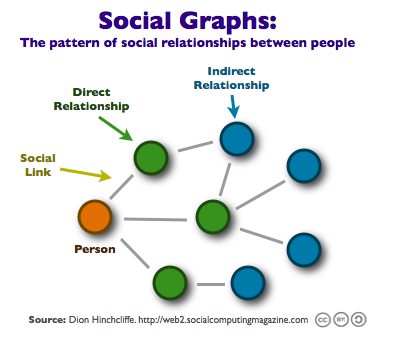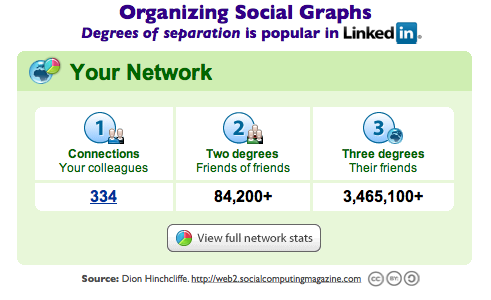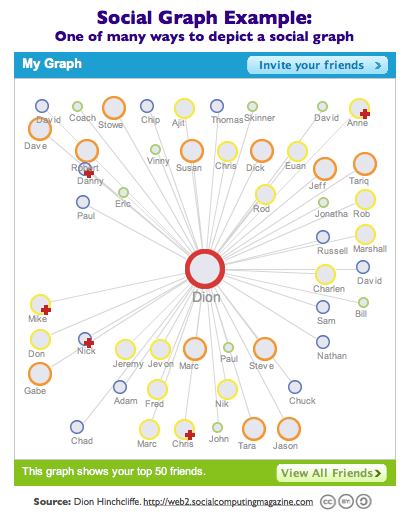One of the hottest topics in the online world in the last couple of years has been the growth of social networking services such as Facebook and MySpace, as well as the addition of a social element to existing user experiences. Despite riding several waves of hype, it’s now clear that the social networking space will only get hotter in 2008 according to most watchers. Social software has come fully into its own as of 2008 — for all appearances permanently — and understanding the reasons for this rapid rise as well as figuring out how to leverage it best is the job of everyone who wants to make the most of the Web 2.0 era.
Gaining a deeper insight to the social networking phenomenon, now exhibited by the tens of millions of users employing them globally on a daily basis for both personal and businesses uses, currently means understanding the fundamental unit of the social network, also one of the biggest new buzzphrases of the year: the social graph. Fortunately, that’s simple enough despite the term’s oblique reference to graph theory, which it is heavily based upon.

Simply put, a social graph is a set of people, referred to as nodes, that are connected together by vertices — better known as links or connections — that reflect their social relationships. You can see a conceptual social graph above, showing the typical distinction of social networks to reflect whether a connection with another person is direct or indirect. For example, the popular business social networking service LinkedIn, uses this model and sorts a member’s social graph into different degrees of separation, which you can see a typical example of below and taken from my LinkedIn profile:

Also becoming popular is the burgeoning field of social analytics, such as the Socalistics application in Facebook and the Interactive Friends Graph, though there are also commercial standalone products here or on the way for the enterprise and open Web spaces from companies like KnowNow and Bravadosoft. The Interactive Friends Graph is a nice, simple example anyone can try on their own and you can see mine from Facebook below. Hovering over nodes in the live version in your Facebook profile allows you to see who is connected to others in your network and begin to gain insight and understanding of the relationships in your network.

But what are the top issues one must understand about the social graph in 2008? As I’ve seen social networks become common on corporate intranets and in daily use on the Web, some of the issues are rapidly becoming clear. However, the full story will certainly continue to unfold for the next several years at least. Here’s what we’re seeing at the moment:
Strategies and Issues for the Social Graph – Circa 2008
- The social graph is poised to replace the address book and contact list as the preferred organizing structure for personal and business relationships. This was one of my Web 2.0 predictions for 2008 and it won’t fully come true for the majority of users for at least several years since there’s such an installed base of traditional tools for managing relationship information. What’s the difference? Social networks are usually opt-in, two-ways for one. And they are social for another, meaning they tend to encourage communication and collaboration, such as through user profile event streams and status messages. They also offer up and actively make use of the deeper insight into the full graph’s social surface area beyond direct contacts, such as LinkedIn’s introduction service.
- Ownership of the social graph is going to be a ground zero issue in 2008. Robert Scoble’s widely covered attempt recently to use Plaxo Pulse to export his 5,000 Facebook contacts recently got him banned temporarily from the service. But as users begin to realize that the contact lists they are building using online Web tools might not be portable, this will become a growing concern, particularly since two-way opt-in makes a social graph more valuable (and accurate) but significantly harder to recreate on demand elsewhere. This takes us to our next subject…
- Many social networking services will adopt open data initiatives. Both Google and Facebook recently showed support for DataPortability.org and Google has an interesting play in their OpenSocial initiative. This is welcome news that will resolve some of the concerns around who owns the graph but interestingly, traditional corporations will be the slowest get this and will rarely let workers take their hard won social graphs and user profiles with them elsewhere as they move to new jobs. Public social networking sites Web sites are leading the way here and this will only drive more business users to the open Web, where they at least have some control over their social graph. Smart organizations will provide their workers with some form of open social graph support, lest they lose control completely as workers keep more and more of their graph in Facebook, LinkedIn, and Plaxo and not in prescribed relationship management tools.
- Attempts to monetize social graphs will drive interest in regulation and legislation. Social networking is now a global Internet phenomenon and that the information contained within them is highly central to everyone’s lives. This will make everything from protecting children to individual privacy of social graphs a hot issue for some local and federal governments. All it will take is one or two widely covered exploits to make this happen. Expect the European Union and the U.S. government to begin seriously examining the issue this year with many other governments following suite. Good citizenship of sites that manage social graphs will be essential to prevent excessive government involvement.
- The line is blurring between personal and business use of social graphs. We’re all rapidly getting one large social graph each already, with everyone we know in them. Most public social networking sites do a poor job of separating different subgroups of our social networks, such as allowing pictures and status messages to only go to a specific subgroups (work messages to business, family message to family, friends messages to friend, etc.) This actually works a little bit better in enterprise social networks, but not much, since it largely consists of a Contact Type field. Segmentation of social graphs will be an increasingly requested feature by users struggling with their use. The social graph management services that make this distinction and enable its leverage may do very well indeed.
- Open Web identity, which will ultimately form the global “primary key” for social graph nodes, will not get anywhere soon. This despite it being needed badly but the users of the Web have not yet felt compelled to demand it. Data portability of social graphs will begin to drive adoption of user controlled Web identity, and hopefully government regulation will not. See Dare Obasanjo’s deep exploration of using openid to enable social graph interoperability as an example of what will need to happen, despite there being little incentive currently for sites to use other site’s openids.
- Making social networking “gardening” and administration easier will drive new innovations. Most individual social graphs are primarily tended by hand today, although a growing number of products, such as Visible Path, do all the tedious work for you by watching your social interaction online such as through tight integration through e-mail and instant messaging, building a rich graph for you (even sending invitations) as you go about your daily social activities. New innovations like these will make social graphs easier to maintain and richer in overall information while also driving adoption through ease of use.
- The optional two-way confirmation of a social graph link becoming standard. Many social graph management platforms (Facebook and Linked for example) require confirmation from the other side of the connection before adding a person to your graph. Sites like Spock, which make it optional, will ultimately be more practical for managing a social graph while still allowing discernment of two way confirmations, which tend to be more valuable and convey key information about the trust and real extent of a social relationship.
- Social networking fatigue will not set in as perceived constraints such as Dunbar’s limit do not prove to be universal. While there are many theories on how big a social graph can get before it become unmanageable and sees diminishing returns on growth (note that both Facebook and LinkedIn encourage ceilings), the fact is that the are many different purposes for a social graph, from data mining and historical research, to marketing and customer relationship management.
What else is going to be key to dealing with the social graph in 2008? Please leave in comments below and I’ll update this post with any good submissions.
